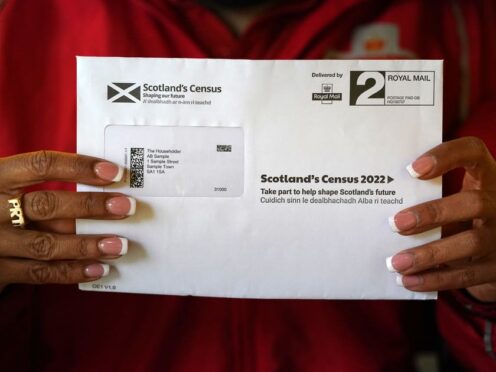More than half of people who responded to Scotland’s 2022 census said they have no religion for the first time in the survey’s history, data shows.
In Scotland’s 2022 census, 51.1% of people responded “no religion” – up from 36.7% in 2011, data released by National Records of Scotland (NRS) showed.
Stating No religion was the most common response in almost every council area in Scotland, though in the Western Isles Church of Scotland remained the most common response and in Inverclyde it was Roman Catholic.
Across Scotland as a whole, 20.4% responded Church of Scotland, down from 32.4% in 2011 while the next largest religious groups were Roman Catholic (13.3%), Other Christian (5.1%) and Muslim (2.2%).
Smaller groups included Hindu (0.55%), Pagan (0.35%), Buddhist (0.28%), Sikh (0.2%) and Jewish (0.11%).
Data also showed that the percentage of people in Scotland with a minority ethnic background increased from 8.2% in the 2011 census to 12.9% in 2022, a larger increase than over the previous decade.
Jon Wroth-Smith, NRS director of Census Statistics, said: “These statistics give a fascinating insight into religion, ethnicity, national identity and language use across Scotland and how they have changed over the years.
“It is exciting to publish the first of topic releases and this, along with our other census data to come, will help local and central government, businesses and charities to plan services in the years ahead.”

Rev David Cameron, Convener of the Assembly Trustees of the Church of Scotland, said the decline in membership numbers is an area of “considerable concern” to the church and that radical reform is necessary to address this.
He said: “It is sobering, and we know that when the Church is measured in this way it can feel hurtful for our members and be a source of anxiety for many.
“But our faith and our relevancy cannot be expressed simply as a set of numbers in a table.”
Census data on topics including ethnic group, national identity, language and migration was published on Tuesday with six further reports on different topics to be released over the coming months.
The 2022 data showed that the percentage of people who said Scottish was their only national identity had increased since the previous 2011 census (from 62.4% to 65.5%).
The percentage who said their only national identity was British also increased (from 8.4% to 13.9%) while the proportion who said they felt both Scottish and British decreased (from 18.3% to 8.2%).
The survey also found that 2.5% of people aged three and over had some skills in Gaelic in 2022, an increase of 43,100 people since 2011 when 1.7% had some skills in Gaelic.
In the Western Isles the majority of people had some Gaelic skills (57.2%) – a far greater level than the next highest council areas, Highland (8.1%) and Argyll and Bute (6.2%).
The percentage of people with some skills in Scots also increased, to 46.2% in 2022 from 37.7% in 2011, and was higher in the north east of Scotland.
Meanwhile, 2.2% of people aged three and over can use British Sign Language (BSL). This was a new question for the 2022 census.
The census also looked at the impact of migration on the population.
Data showed that the percentage of people in Scotland born outside the UK increased from 7% to 10.2% between 2011 and 2022.
The census found that Scotland’s population is aging, but has grown by 144,400 (2.7%) since 2011, with the increase driven by migration.
Between 2011 and 2022 the number of people living in Scotland who were born in Scotland decreased by 90,400.
However, this decrease was offset by increases in the number who were born in the rest of the UK (up 49,200) and born overseas (up 185,600).
The report said that the increase in Scotland’s population was driven by an increase in people born outside of Scotland.
It noted that while Scotland’s population is aging, “migration from the rest of the UK and overseas means we have more people in younger age groups than we otherwise would”.
Mr Wroth-Smith said: “Without migration, Scotland’s population would have decreased, and we would have fewer people in younger age groups.”
There has been a census in Scotland every 10 years since 1801, except 1941, and the 2021 census in Scotland was moved to 2022 due to the impact of the Covid-19 pandemic.
Deputy First Minister and Gaelic Secretary Kate Forbes said the increase in people with some Gaelic skills is “another important step in securing the future of the language”.
She added: “The forthcoming Scottish Languages Bill will build on this progress, along with continued Scottish Government funding for Gaelic arts, education, broadcasting and community initiatives.
“My appointment as Scotland’s first Cabinet Secretary for Gaelic is a further sign of this Government’s determination to preserve Gaelic as a vital part of our culture.”
